The Impact of Local Microclimate Boundary Conditions on Building Energy Performance
Abstract
:1. Introduction
2. Method and Measurement
2.1. Microclimatic and Meteorological Monitoring
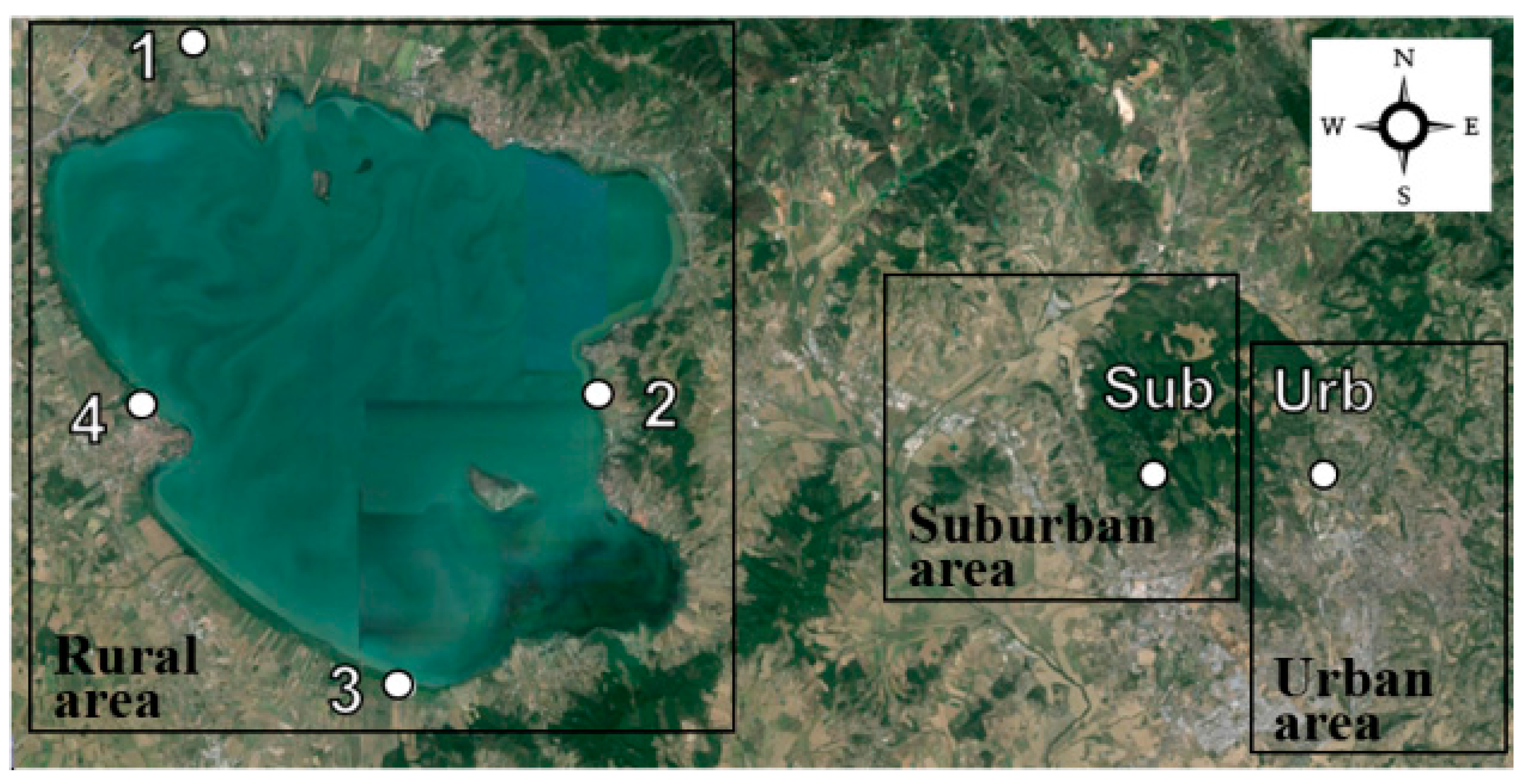
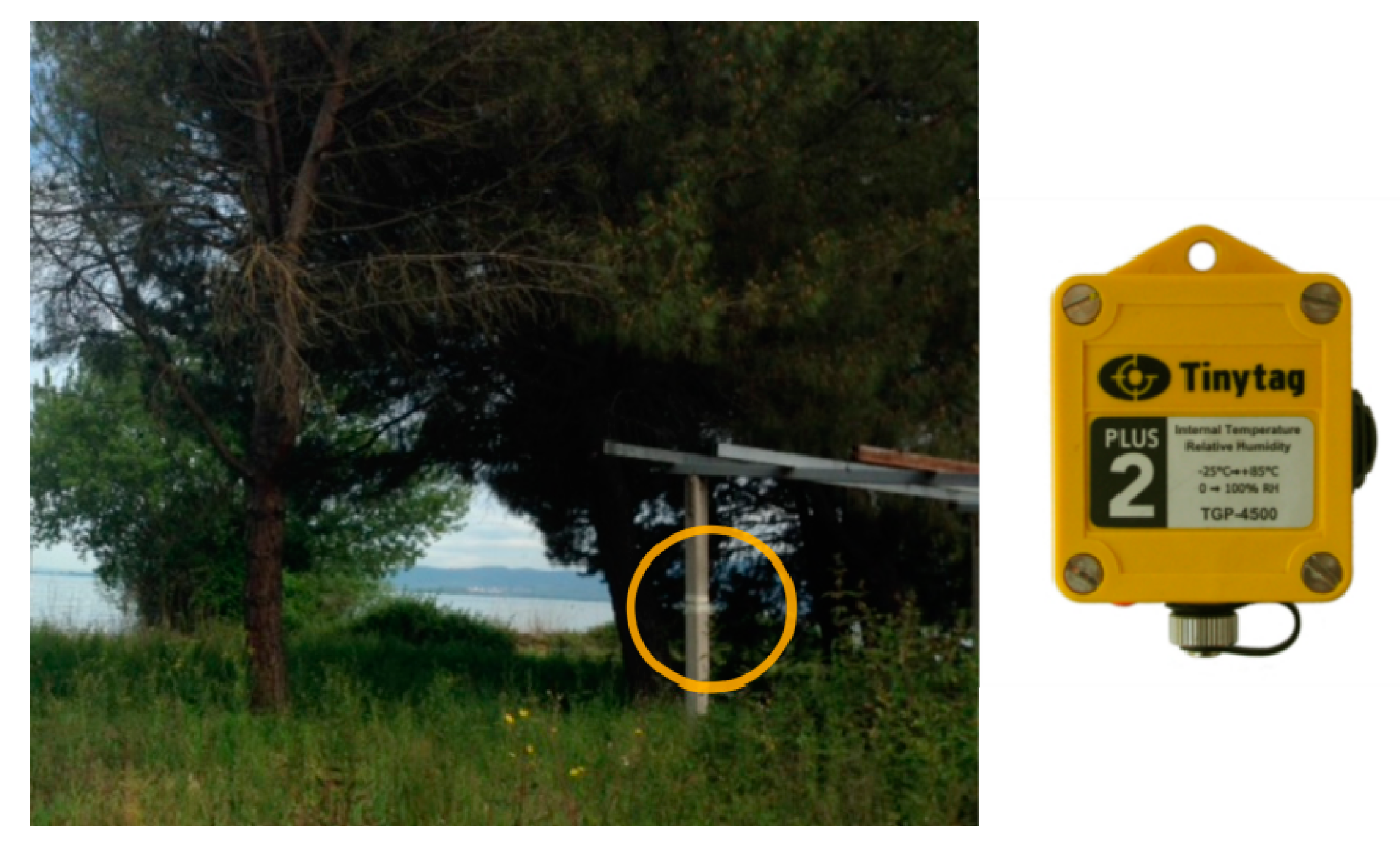
| Measurement Spot no. | Village Name | Relative Position to the Lake | Vegetation Presence | Altitude [m a.s.l.] | Height * [m] |
|---|---|---|---|---|---|
| 1 | Tuoro | North | moderate | 267 | 4 |
| 2 | Torricella | East | rich | 258 | 2 |
| 3 | Mirabella | South | moderate | 258 | 2 |
| 4 | Castiglione del Lago | West | moderate | 259 | 4 |
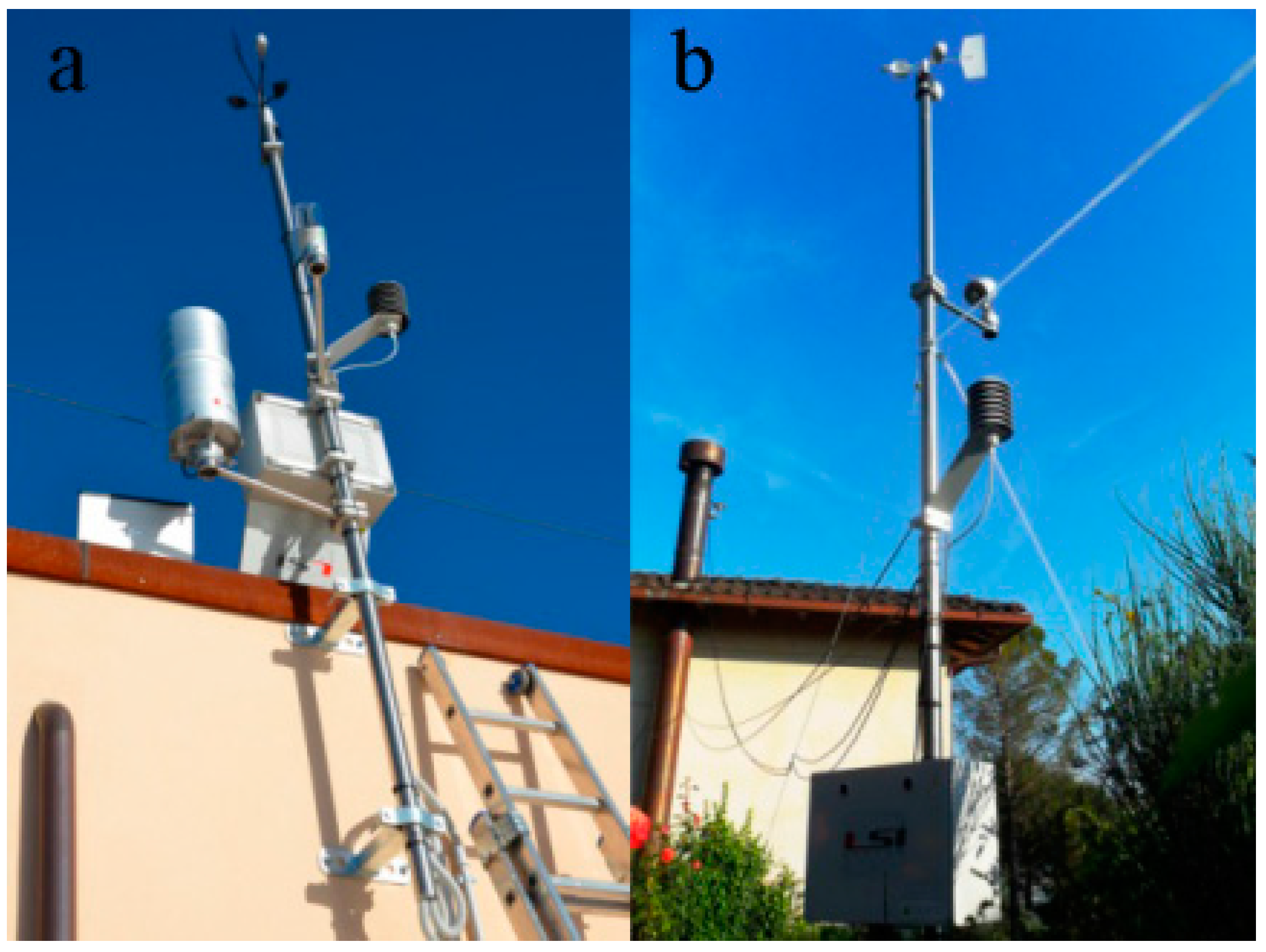
| Meteorological Station no. | Location Name | Distance to the Lake [km] | Level of Urbanization | Vegetation Presence | Altitude [m a.s.l.] | Height * [m] |
|---|---|---|---|---|---|---|
| Sub | Corciano | 16.5 | low | plentiful | 520 | 2.5 |
| Urb | Perugia | 20.3 | average | moderate | 320 | 2.5 |
2.2. Analysis of Building Energy Requirement with Varying Weather Conditions
2.3. Energy Dynamic Simulation Modeling of the Case Study Building
| Reference Residential Building Location | |
|---|---|
| Location | Perugia, Italy |
| Latitude | 43°08′N |
| Longitude | 12°50′E |
| Elevation above sea level | 258 m a.s.l. |
| Orientation | 120° |
| Floor area | 100 m2 |
| S/V ratio | 0.76 |
| Construction Properties | Layers | Thickness | ||
|---|---|---|---|---|
| Thermal Transmittance | Internal Heat Capacity | |||
| External wall | 0.275 W/m2K | 128.8 kJ/m2K | 1. Brickwork | 120 mm |
| 2. Plasterboard | 10 mm | |||
| 3. EPS expanded polystyrene | 90 mm | |||
| 4. Brickwork | 250 mm | |||
| 5. Gypsum plastering | 20 mm | |||
| Internal wall | 3.4 W/m2K | 68.0 kJ/m2K | 1. Cement plaster | 20 mm |
| 2. Perforated brickwork | 80 mm | |||
| Roof | 0.240 W/m2K | 50.7 kJ/m2K | 1. Clay tile (roofing) | 15 mm |
| 2. MW stone wool | 15 mm | |||
| 3. Air gap 300 mm | 50 mm | |||
| 4. MW stone wood | 80 mm | |||
| 5. Aerated concrete slab | 200 mm | |||
| 6. Gypsum plastering | 15 mm | |||
3. Case Study
4. Results and Discussion
4.1. Continuous Monitoring
- -
- winter, 20 January–30 April 2014;
- -
- summer, 12 July–23 August 2014.
4.1.1. Air Temperature
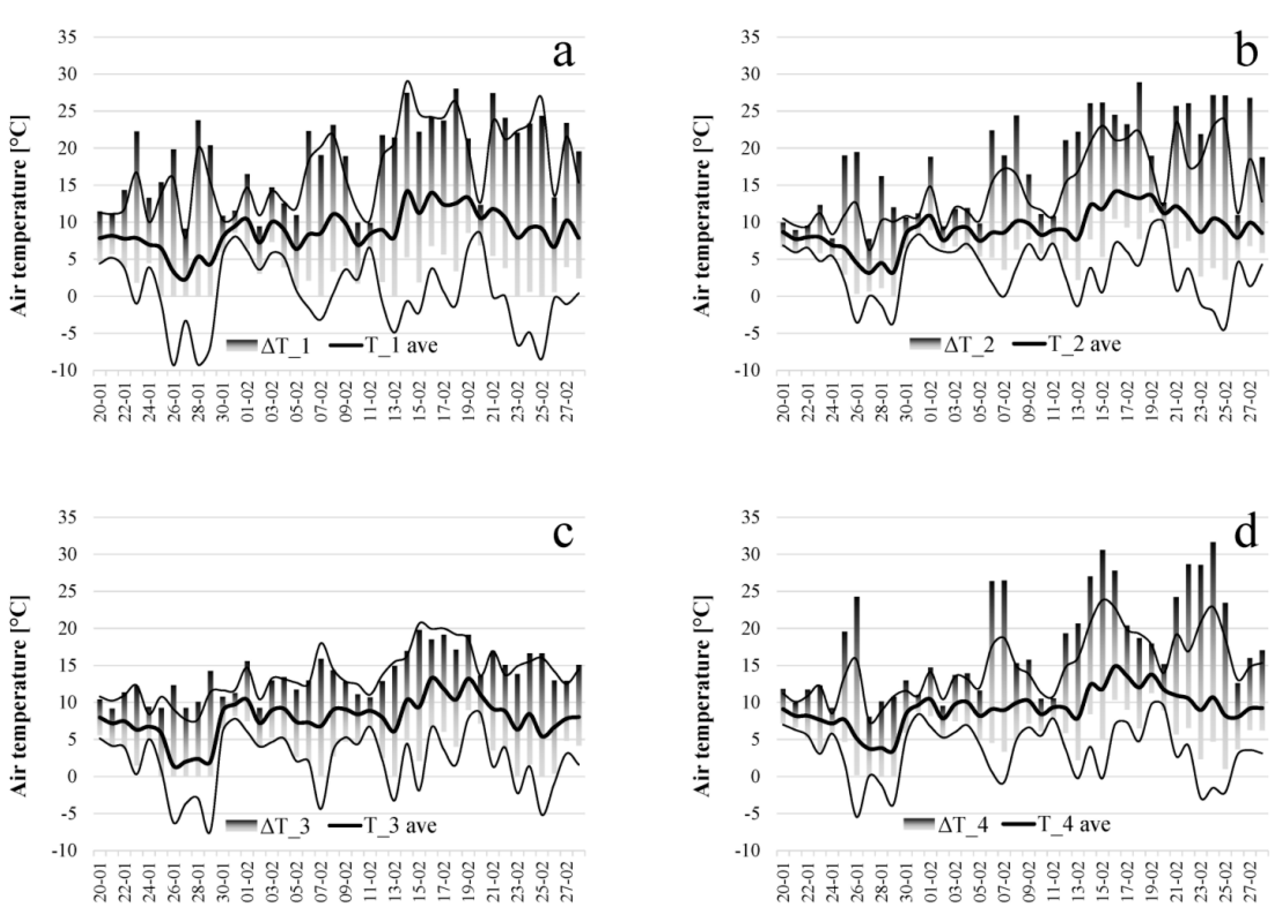
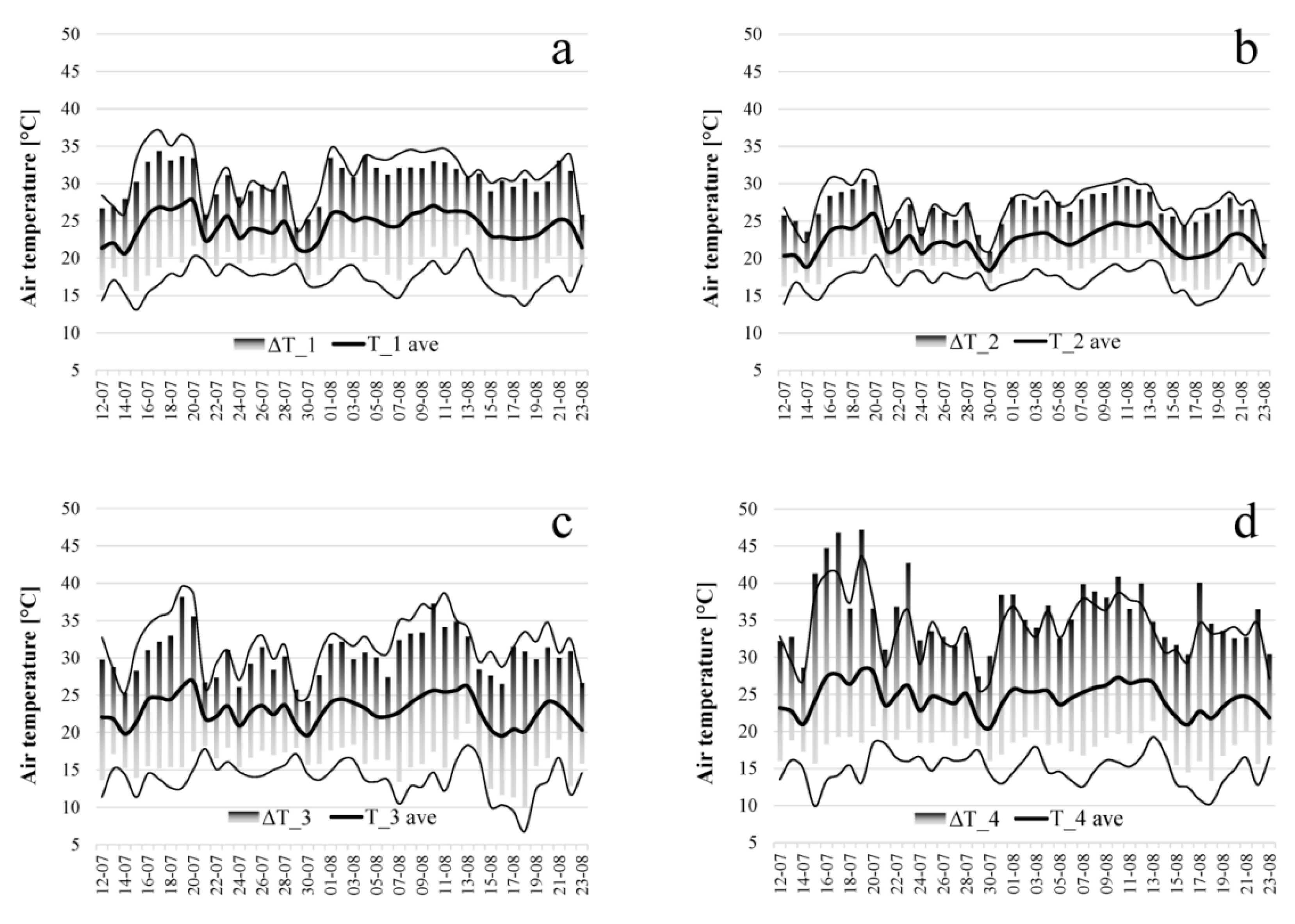
| T_1 | T_2 | T_3 | T_4 | |
|---|---|---|---|---|
| T_1 | 1 | 0.75 | 0.82 | 0.77 |
| T_2 | 0.75 | 1 | 0.91 | 0.94 |
| T_3 | 0.82 | 0.91 | 1 | 0.94 |
| T_4 | 0.77 | 0.94 | 0.94 | 1 |
| T_Rur | T_Sub | T_Urb | |
|---|---|---|---|
| T_Rur | 1 | 0.86 | 0.93 |
| T_Sub | 0.86 | 1 | 0.95 |
| T_Urb | 0.93 | 0.95 | 1 |
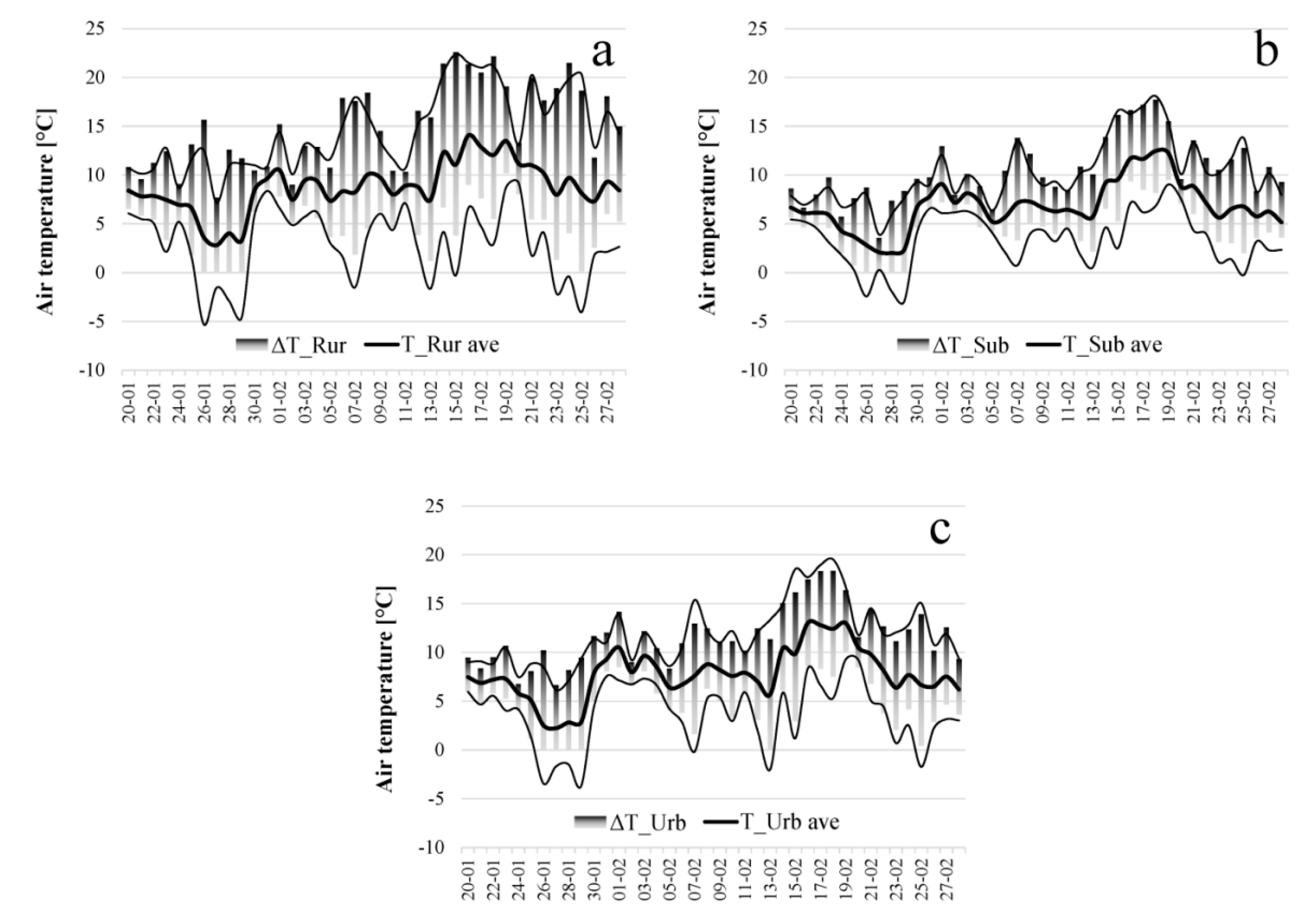
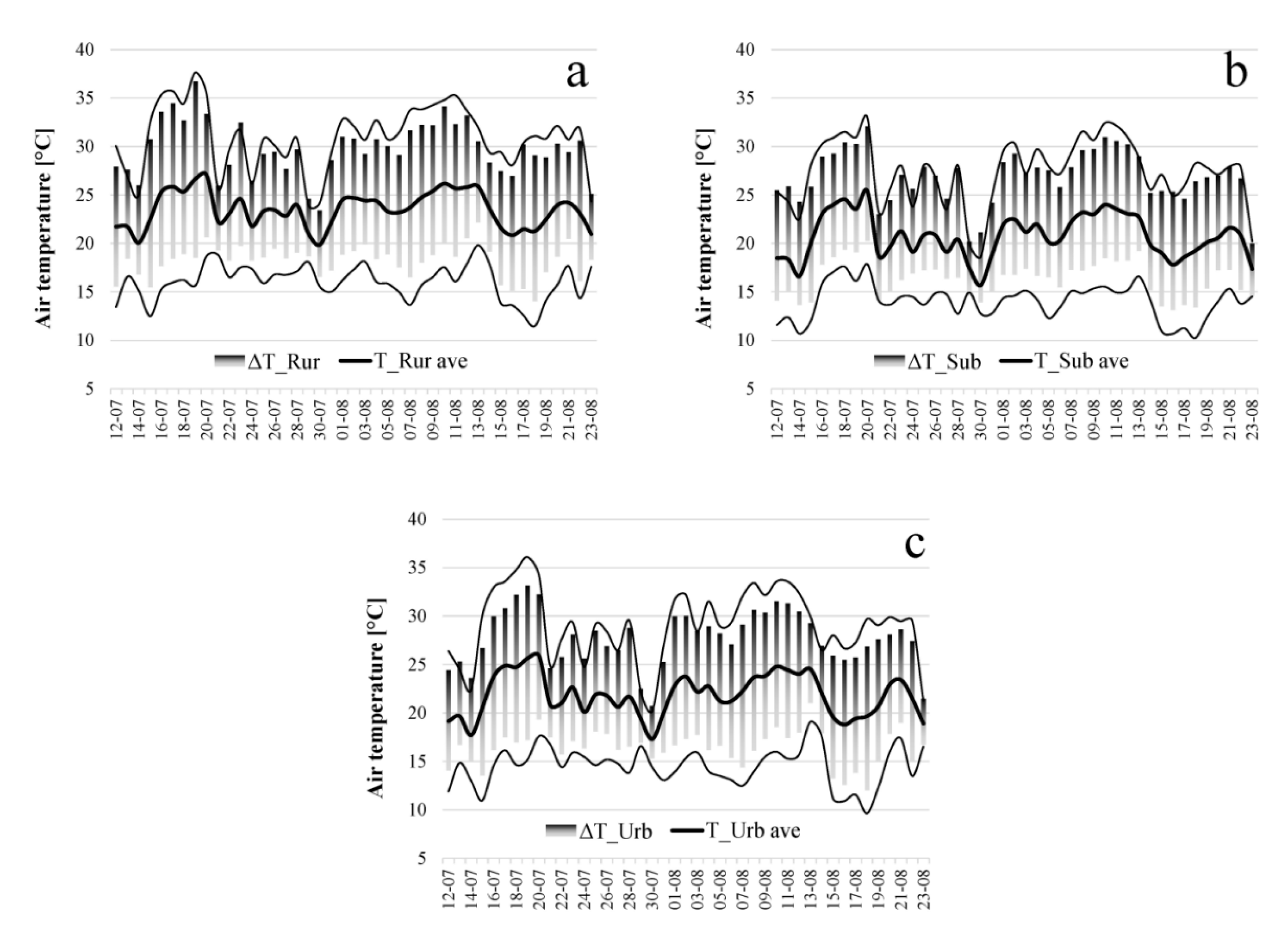
| T_Rur [°C] | T_Sub [°C] | T_Urb [°C] | |
|---|---|---|---|
| January | 6.4 ± 3.2 | 4.7 ± 2.5 | 5.6 ± 3.0 |
| February | 9.7 ± 4.0 | 7.7 ± 2.5 | 8.7 ± 3.2 |
| March | 11.1 ± 5.4 | 8.9 ± 4.1 | 9.8 ± 4.2 |
| April | 14.6 ± 5.2 | 11.8 ± 3.8 | 12.8 ± 3.9 |
| July | 23.2 ± 4.2 | 20.3 ± 4.1 | 21.5 ± 4.3 |
| August | 23.7 ± 4.3 | 21.1 ± 4.1 | 22.1 ± 4.4 |
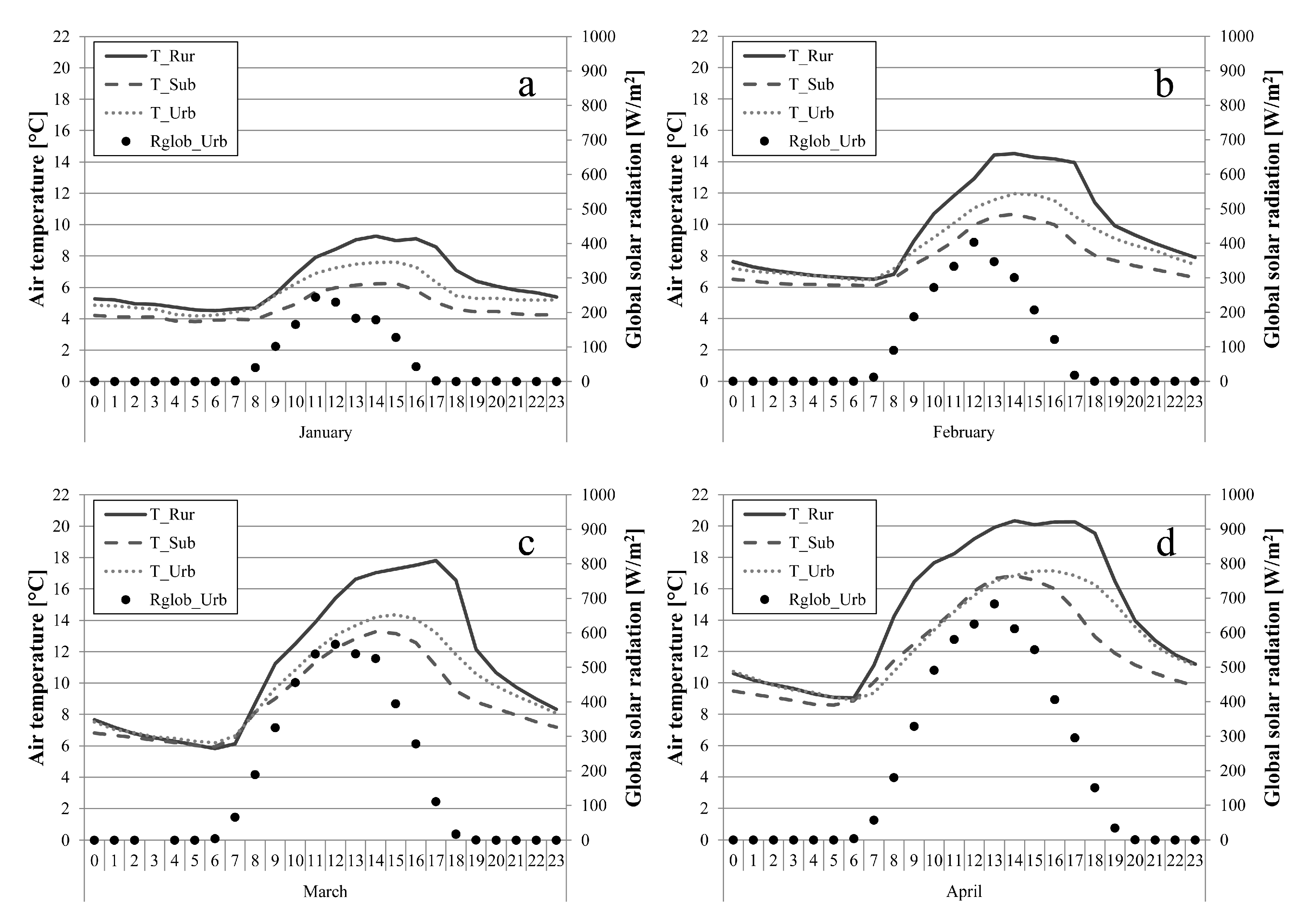
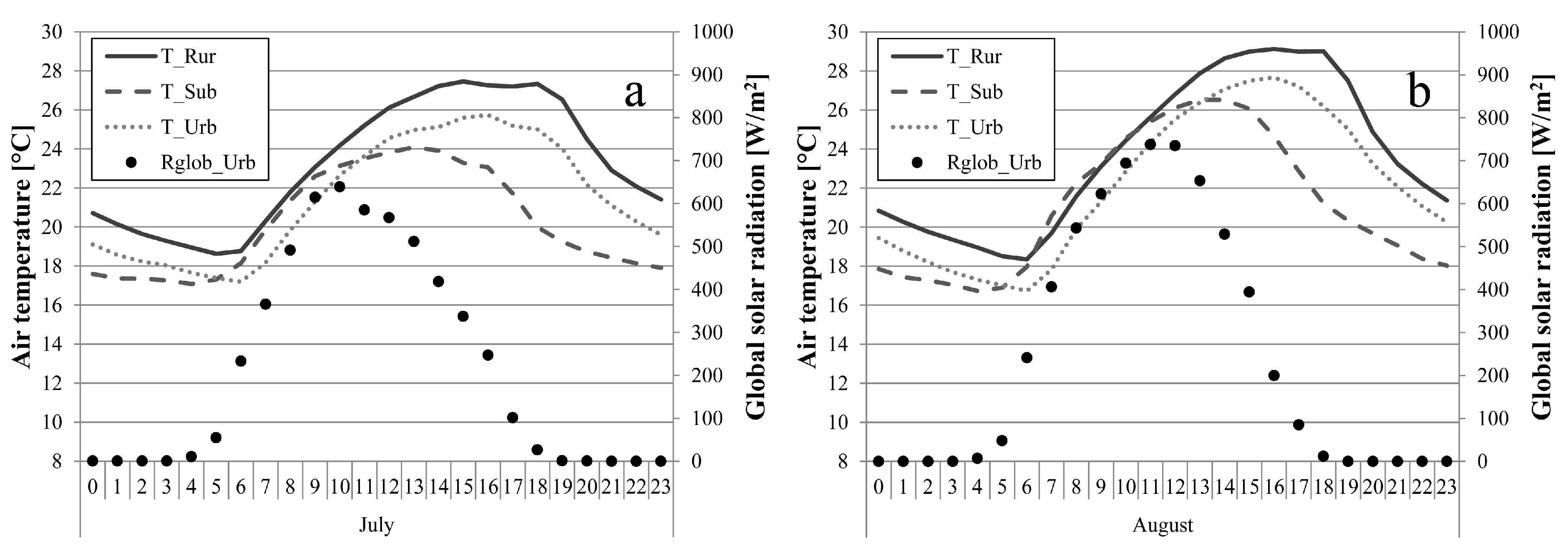
| Average daily Air Temperature [°C] (7:00 a.m.–9:00 p.m.) | Average Nightly Air Temperature [°C] (10:00 p.m.–6.00 a.m.) | |||||
|---|---|---|---|---|---|---|
| Max | Ave | Min | Max | Ave | Min | |
| T_Rur | 18.4 | 13.3 | 6.3 | 12.5 | 7.8 | 1.9 |
| T_Sub | 14.8 | 10.2 | 4.3 | 11.7 | 7.0 | 2.0 |
| T_Urb | 16.0 | 11.2 | 5.0 | 12.9 | 7.7 | 1.8 |
| Average Daily Air Temperature [°C] (7:00 a.m.–9:00 p.m.) | Average Nightly Air Temperature [°C] (10:00 p.m.–6.00 a.m.) | |||||
|---|---|---|---|---|---|---|
| Max | Ave | Min | Max | Ave | Min | |
| T_Rur | 30.5 | 25.6 | 19.9 | 23.8 | 20.0 | 16.1 |
| T_Sub | 27.8 | 22.6 | 15.8 | 21.2 | 17.5 | 13.9 |
| T_Urb | 28.9 | 23.8 | 17.3 | 23.3 | 18.5 | 14.2 |
4.1.2. Air Relative Humidity
| RH_Rur [%] | RH_Sub [%] | RH_Urb [%] | |
|---|---|---|---|
| January | 92 | 85 | 89 |
| February | 86 | 74 | 83 |
| March | 75 | 73 | 68 |
| April | 76 | 74 | 70 |
| July | 72 | 53 | 70 |
| August | 71 | 55 | 65 |
4.1.3. Wind Speed and Wind Direction
4.2. Building Energy Requirement
4.2.1. Degree Hour Method
4.2.2. Dynamic Simulation
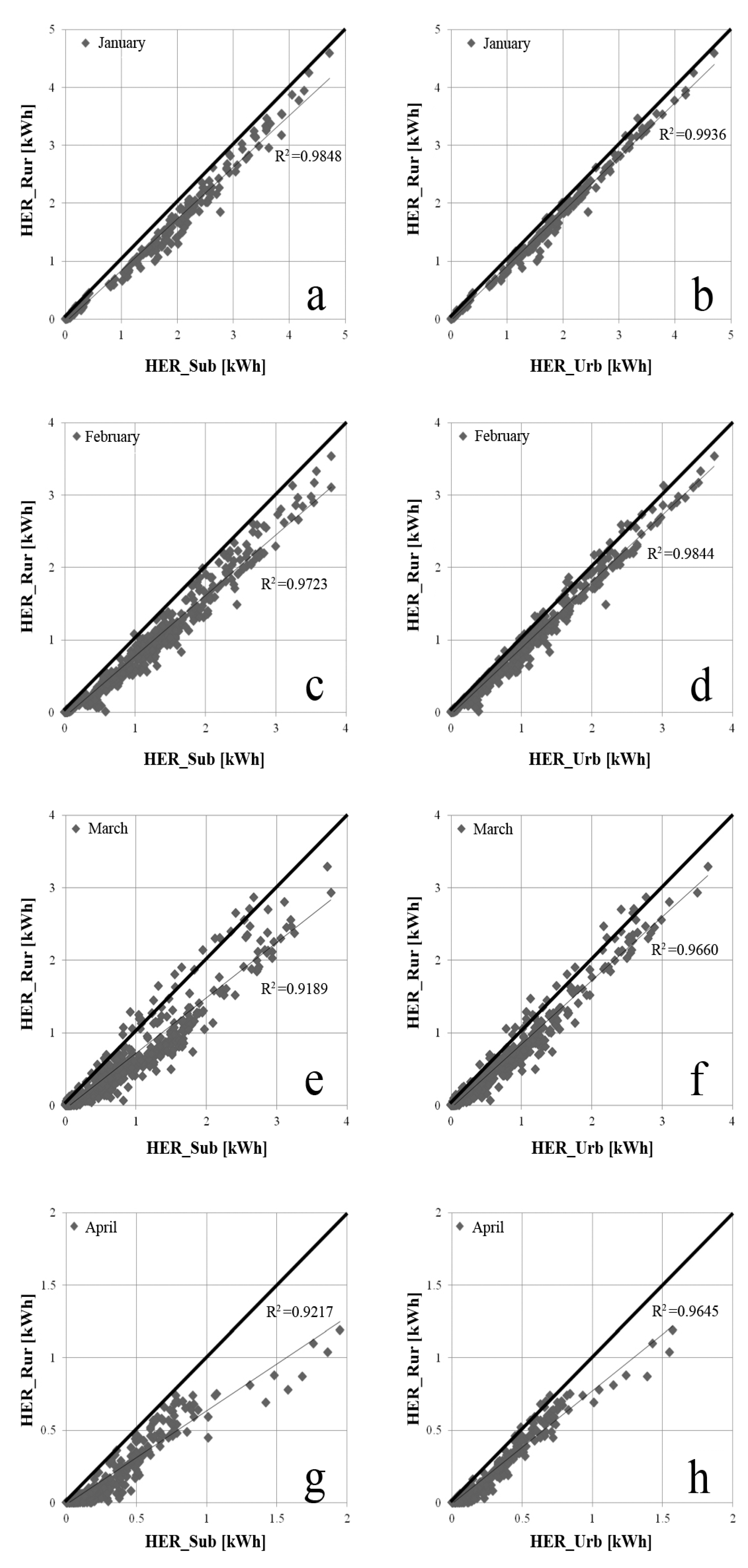
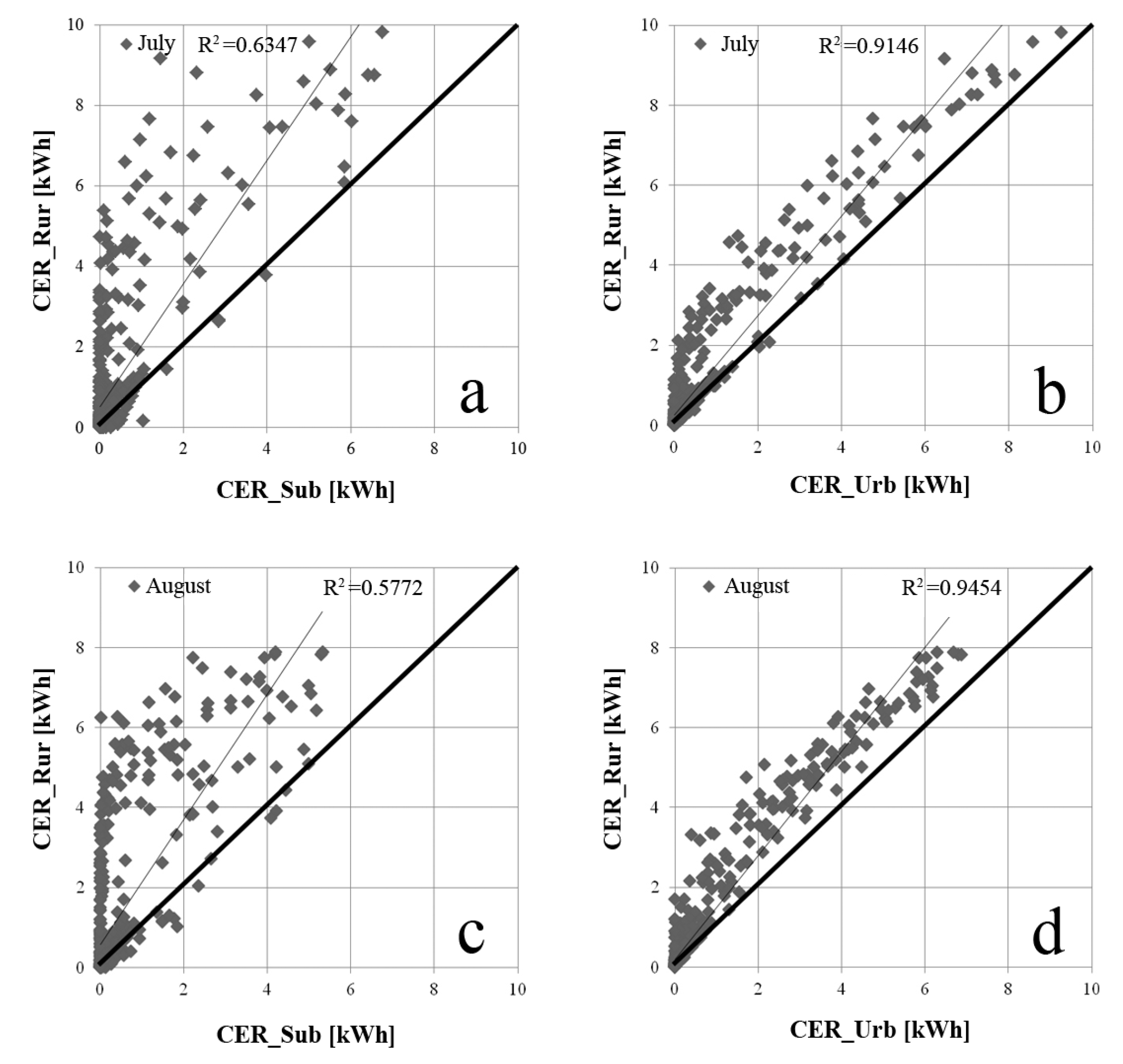
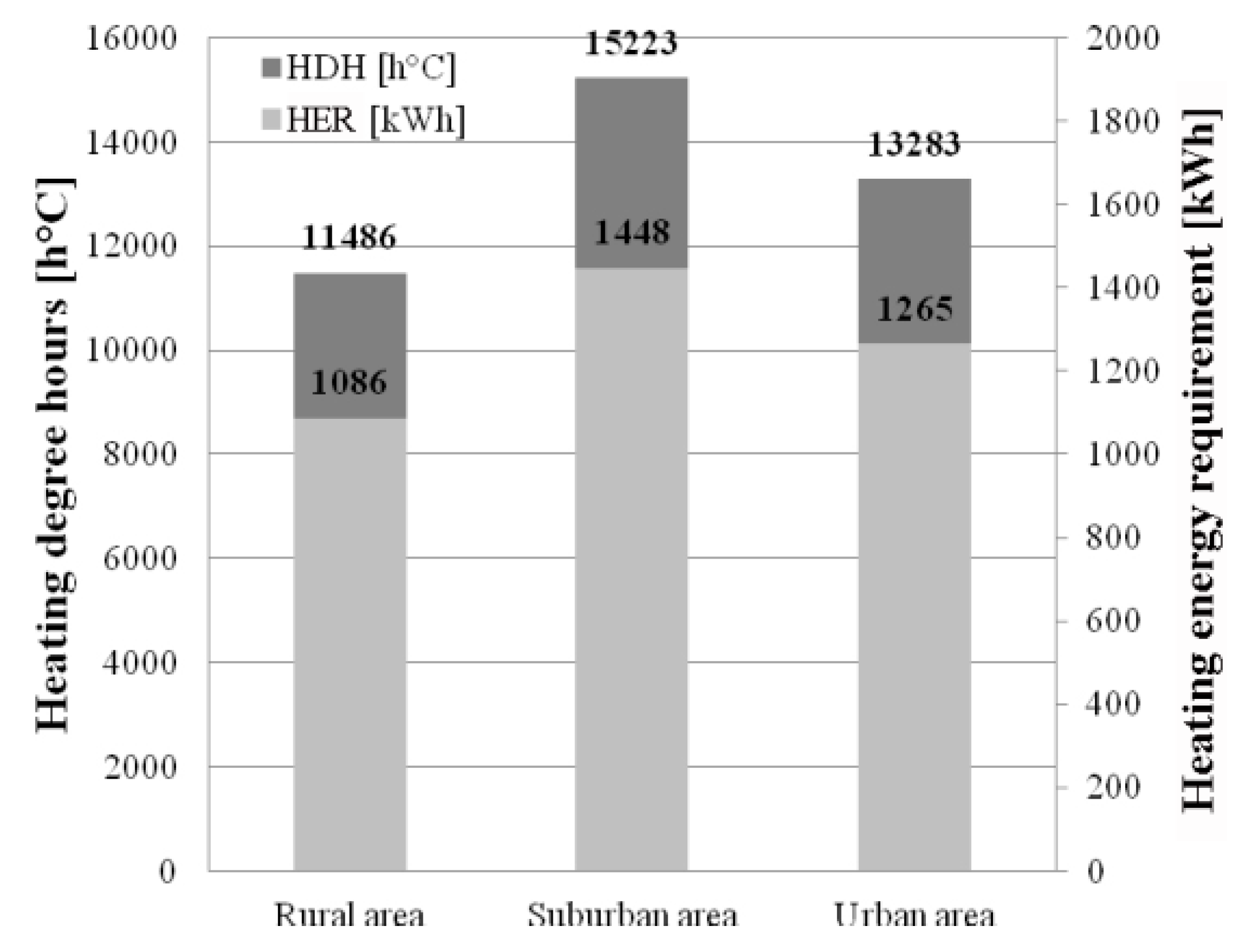
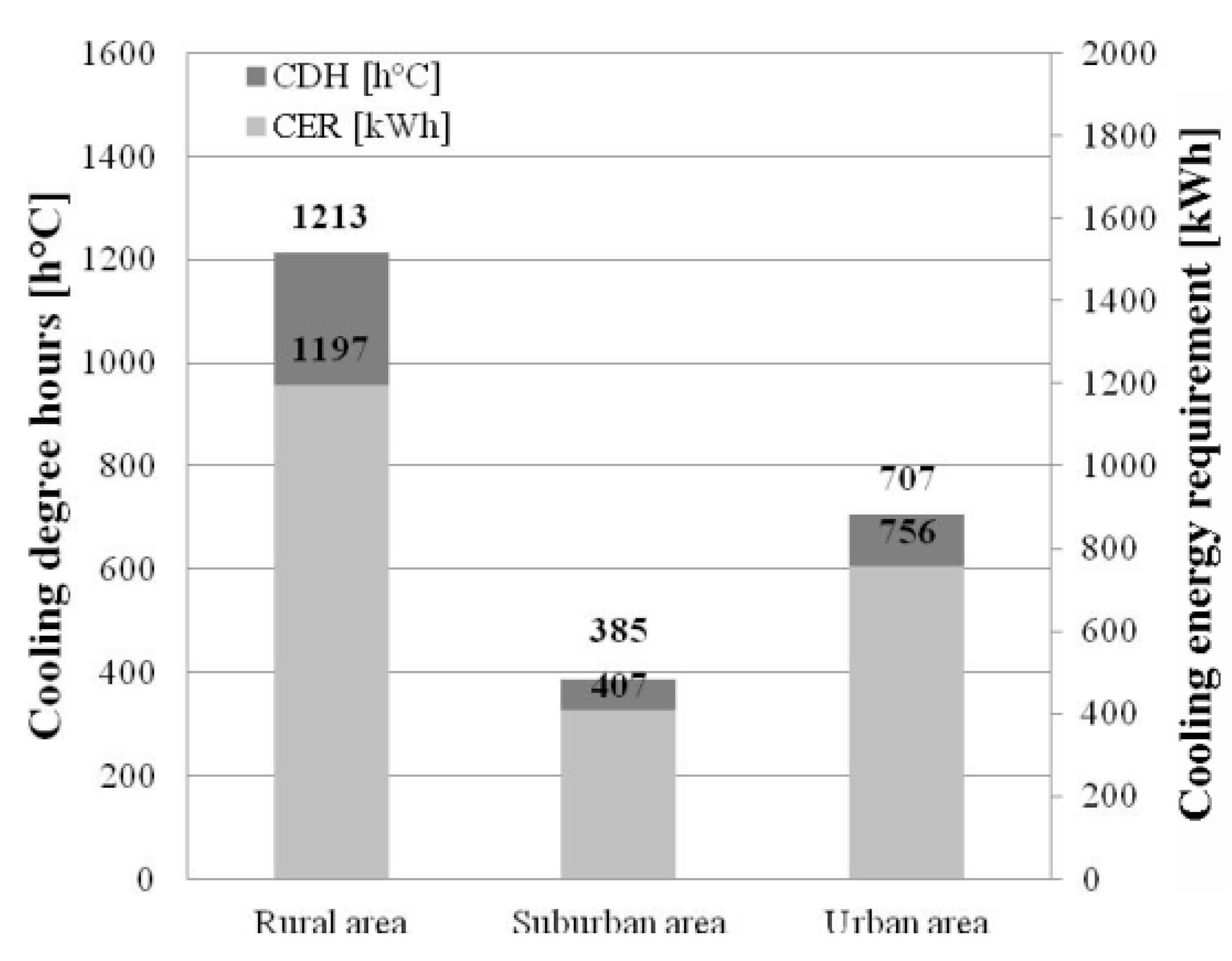
5. Conclusions
6. Limitations and Future Developments
Acknowledgments
Author Contributions
Conflicts of Interest
Nomenclature
| “T” | Dry bulb air temperature [°C] |
| “RH” | Air relative humidity [%] |
| “1” | Tuoro measurement spot—North side of the Lake |
| “2” | Torricella measurement spot—East side of the Lake |
| “3” | Mirabella measurement spot—South side of the Lake |
| “4” | Castiglione del Lago measurement spot—West side of the Lake |
| “Sub” | Weather station located in the suburban area, i.e., Corciano (PG) |
| “Urb” | Weather station situated in the urban area, i.e., Perugia |
| “Ti” | Outdoor air temperature [°C] |
| “Tr” | Reference temperature [°C] |
| “HDH” | Heating degree hour index [h°C] |
| “CDH” | Cooling degree hour index [h°C] |
| “HER” | Heating energy requirement [kWh] |
| “CER” | Cooling energy requirement [kWh] |
References
- De Wilde, P.; Coley, D. The implications of a changing climate for buildings. Build. Environ. 2012, 55, 1–7. [Google Scholar] [CrossRef] [Green Version]
- Summerfield, A.J.; Lowe, R. Challenges and future directions for energy and buildings research. Build. Res. Inf. 2012, 40, 391–400. [Google Scholar] [CrossRef]
- Simmonds, I.; Keay, K. Weekly cycle of meteorological variation in Melbourne and the role of pollution and anthropogenic heat release. Atmos. Environ. 1997, 31, 1589–1603. [Google Scholar] [CrossRef]
- Kanda, M. Progress in Urban Meteorology: A review. J. Meteorol. Soc. Jpn. 2007, 85, 363–383. [Google Scholar] [CrossRef]
- Flagg, D.D.; Taylor, P.A. Sensitivity of mesoscale model urban boundary layer meteorology to the scale of urban representation. Atmos. Chem. Phys. 2011, 6, 2951–2972. [Google Scholar] [CrossRef] [Green Version]
- Bevilacqua, P.; Coma, J.; Pérez, G.; Chocarro, C.; Juárez, A.; Solé, C.; de Simone, M.; Cabeza, L.F. Plant cover and floristic composition effect on thermal behaviour of extensive green roofs. Build. Environ. 2015, 92, 305–316. [Google Scholar] [CrossRef]
- Salata, F.; Golasi, I.; Vollaro, A.D.L.; Vollaro, R.D.L. How high albedo and traditional buildings’ materials and vegetation affect the quality of urban microclimate. A case study. Energy Build. 2015, 99, 32–49. [Google Scholar] [CrossRef]
- Susorova, I.; Azimi, P.; Stephens, B. The effects of climbing vegetation on the local microclimate, thermal performance, and air infiltration of four building facade orientations. Build. Environ. 2014, 76, 113–124. [Google Scholar] [CrossRef]
- Tao, H.; Fraedrich, K.; Menz, C.; Zhai, J. Trends in extreme temperature indices in the Poyang Lake Basin, China. Stoch. Environ. Res. Risk Assess. 2014, 28, 1543–1553. [Google Scholar] [CrossRef]
- Chen, Z.; Zhao, L.; Meng, Q.; Wang, C.; Zhai, Y.; Wang, F. Field measurements on microclimate in residential community in Guangzhou, China. Front. Archit. Civil Eng. China 2009, 3, 462–468. [Google Scholar] [CrossRef]
- Long, Z.; Perrie, W.; Gyakum, J.; Caya, D.; Laprise, R. Northern lake impacts on local seasonal climate. J. Hydrometeorol. 2007, 6, 881–896. [Google Scholar] [CrossRef]
- Wuebbles, D.J.; Hayhoe, K.; Parzen, J. Introduction: Assessing the effects of climate change on Chicago and the Great Lakes. J. Great Lakes Res. 2010, 36, 1–6. [Google Scholar] [CrossRef]
- Pisello, A.L.; Piselli, C.; Cotana, F. Thermal-physics and energy performance of an innovative green roof system: The Cool-Green Roof. Sol. Energy 2015, 116, 337–356. [Google Scholar] [CrossRef]
- Han, Y.Q.; Taylor, J.E.; Pisello, A.L. Toward mitigating urban heat island effects: Investigating the thermal-energy impact of bio-inspired retro-reflective building envelopes in dense urban settings. Energy Build. 2015, 102, 308–389. [Google Scholar] [CrossRef]
- Santamouris, M. On the energy impact of urban heat island and global warming on buildings. Energy Build. 2014, 82, 100–113. [Google Scholar] [CrossRef]
- Sørensen, L.S. Heat transmission coefficient measurements in buildings utilizing a heat loss measuring device. Sustainability 2013, 5, 3601–3614. [Google Scholar] [CrossRef]
- Santamouris, M.; Papanikolaou, N.; Nivada, I.; Koronakis, I.; Georgakis, C.; Argiriou, A.; Assimakopoulos, D.N. On the impact of urban climate on the energy consumption of buildings. Sol. Energy 2001, 70, 201–216. [Google Scholar] [CrossRef]
- Chappells, H.; Shove, E. Debating the future of comfort: Environmental sustainability, energy consumption and the indoor environment. Build. Res. Inf. 2005, 33, 32–40. [Google Scholar] [CrossRef]
- Wagner, K. Generation of a tropically adapted energy performance certificate for residential buildings. Sustainability 2014, 6, 8415–8431. [Google Scholar] [CrossRef]
- Theophilou, M.K.; Serghides, D. Heat island effect for Nicosia, Cyprus. Adv. Build. Energy Res. 2014, 1, 63–73. [Google Scholar] [CrossRef]
- Cartalis, C.; Synodinou, A.; Tsangrassoulis, A.; Santamouris, M. Modifications in energy demand in urban area as a result of climate changes: An assessment for the southeast Mediterranean region. Energy Convers. Manag. 2001, 42, 1647–1656. [Google Scholar] [CrossRef]
- Argiriou, A.; Lykoudis, S.; Kontoyiannidis, S.; Balaras, C.A.; Asimakopoulos, D.; Petrakis, M.; Kassomenos, P. Comparison of methodologies for TMY generation using 20 years data for Athens, Greece. Solar Energy 1999, 66, 33–45. [Google Scholar] [CrossRef]
- Cheong, C.H.; Kim, T.; Leigh, S.-B. Thermal and daylighting performance of energy-efficient windows in highly glazed residential buildings: Case study in Korea. Sustainability 2014, 6, 7311–7333. [Google Scholar] [CrossRef]
- Jentsch, M.F.; Bahaj, A.S.; James, P.A.B. Climate change future proofing of buildings-generation and assessment of building simulation weather files. Energy Build. 2008, 40, 2148–2168. [Google Scholar] [CrossRef]
- Matzarakis, A.; Balafoutis, C. Heating degree-days over Greece as an index of energy. Int. J. Climatol. 2004, 24, 1817–1828. [Google Scholar] [CrossRef]
- Al-Hadhrami, L.M. Comprehensive review of cooling and heating degree days characteristics over Kingdom of Saudi Arabia. Renew. Sustain. Energy Rev. 2013, 27, 305–314. [Google Scholar] [CrossRef]
- Durmayaz, A.; Kadioglu, M.; Sen, Z. An application of the degree-hours method to estimate the residential heating energy requirement and fuel consumption in Istanbul. Energy 2000, 25, 1245–1256. [Google Scholar] [CrossRef]
- Tselepidaki, I.; Santamouris, M.; Asimakopoulos, D.N.; Kontoyiannidis, S. On the variability of cooling degree-days in an urban environment: Applications to Athens, Greece. Energy Build. 1994, 21, 93–99. [Google Scholar] [CrossRef]
- Crawley, D.B.; Hand, J.W.; Kummert, M.; Griffith, B.T. Contrasting the capabilities of building energy performance simulation programs. Build. Environ. 2008, 43, 661–673. [Google Scholar] [CrossRef] [Green Version]
- Bianchi, F.; Pisello, A.L.; Baldinelli, G.; Asdrubali, F. Infrared thermography assessment of thermal bridges in building envelope: Experimental validation in a test room setup. Sustainability 2014, 6, 7107–7120. [Google Scholar] [CrossRef]
- Battista, G.; Evangelisti, L.; Guattari, C.; Basilicata, C.; de Lieto Vollaro, R. Buildings energy efficiency: Interventions analysis under a smart cities approach. Sustainability 2014, 6, 4694–4705. [Google Scholar] [CrossRef]
- Canto-Perello, J.; Martinez-Garcia, M.P.; Curiel-Esparza, J.; Martin-Utrillas, M. Implementing sustainability criteria for selecting a roof assembly typology in medium span buildings. Sustainability 2015, 7, 6854–6871. [Google Scholar] [CrossRef]
- Chan, A.L.S. Developing future hourly weather files for studying the impact of climate change on building energy performance in Hong Kong. Energy Build. 2011, 43, 2860–2868. [Google Scholar] [CrossRef]
- Papakostas, K.; Kyriakis, N. Heating and cooling degree-hours for Athens and Thessaloniki, Greece. Renew. Energy 2005, 30, 1873–1880. [Google Scholar] [CrossRef]
- Christenson, M.; Manz, H.; Gyalistras, D. Climate warming impact on degree-days and building energy demand in Switzerland. Energy Conserv. Manag. 2006, 47, 671–686. [Google Scholar] [CrossRef]
- Giannakopolos, C.; Hadjinicolaou, P.; Zerefos, C.; Demosthenous, G. Changing energy requirements in the Mediterranean under changing climatic conditions. Energies 2009, 2, 805–815. [Google Scholar] [CrossRef]
- American Society of Heating, Refrigerating and Air-Conditioning Engineers. ASHRAE Handbook Fundamentals; American Society of Heating, Refrigerating and Air-Conditioning Engineers, Inc.: Atlanta, GA, USA, 2011. [Google Scholar]
- Crawley, D.B.; Lawrie, L.K.; Winkelmann, F.C.; Buhl, W.F.; Huang, Y.J.; Pedersen, C.O.; Strand, R.K.; Liesen, R.J.; Fisher, D.E.; Witte, M.J.; et al. Energy Plus: Creating a new-generation building energy simulation program. Energy Build. 2001, 33, 319–331. [Google Scholar] [CrossRef]
- Bianco, V.; de Rosa, M.; Scarpa, F.; Tagliafico, L.A. Analysis of energy demand in residential buildings for different climates by means of dynamic simulation. Int. J. Ambient Energy 2014. [Google Scholar] [CrossRef]
- American Society of Heating, Refrigerating and Air-Conditioning Engineers. ANSI/ASHRAE 55-2013: Thermal Environmental Conditions for Human Occupancy; American Society of Heating, Refrigerating and Air-Conditioning Engineers: Atlanta, GA, USA, 2013. [Google Scholar]
- Giannopoulou, K.; Livada, I.; Santamouris, M.; Saliari, M.; Assimakopoulos, M.; Caouris, Y.G. On the characteristics of the summer urban heat island in Athens, Greece. Sustain. Cities Soc. 2011, 1, 16–28. [Google Scholar] [CrossRef]
- Asdrubali, F.; D’Alessandro, F.; Schiavoni, S. A review of unconventional sustainable building insulation materials. Sustain. Mater. Technol. 2015. [Google Scholar] [CrossRef]
© 2015 by the authors; licensee MDPI, Basel, Switzerland. This article is an open access article distributed under the terms and conditions of the Creative Commons Attribution license (http://creativecommons.org/licenses/by/4.0/).
Share and Cite
Pisello, A.L.; Pignatta, G.; Castaldo, V.L.; Cotana, F. The Impact of Local Microclimate Boundary Conditions on Building Energy Performance. Sustainability 2015, 7, 9207-9230. https://doi.org/10.3390/su7079207
Pisello AL, Pignatta G, Castaldo VL, Cotana F. The Impact of Local Microclimate Boundary Conditions on Building Energy Performance. Sustainability. 2015; 7(7):9207-9230. https://doi.org/10.3390/su7079207
Chicago/Turabian StylePisello, Anna Laura, Gloria Pignatta, Veronica Lucia Castaldo, and Franco Cotana. 2015. "The Impact of Local Microclimate Boundary Conditions on Building Energy Performance" Sustainability 7, no. 7: 9207-9230. https://doi.org/10.3390/su7079207
APA StylePisello, A. L., Pignatta, G., Castaldo, V. L., & Cotana, F. (2015). The Impact of Local Microclimate Boundary Conditions on Building Energy Performance. Sustainability, 7(7), 9207-9230. https://doi.org/10.3390/su7079207








